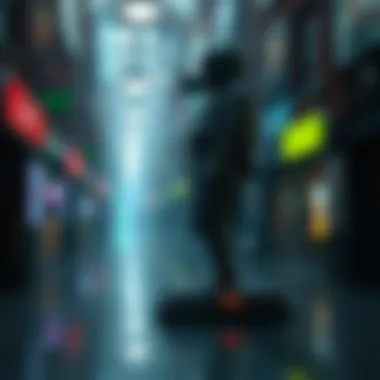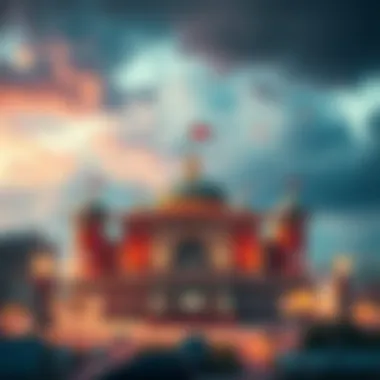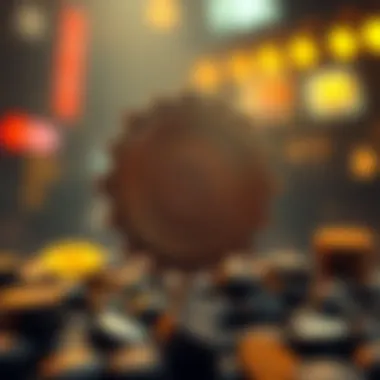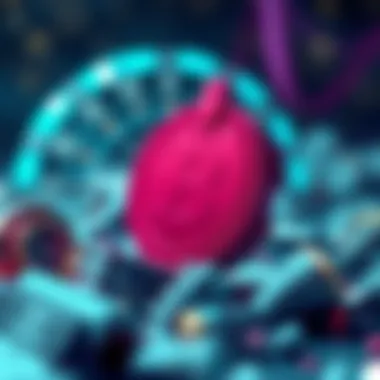Creating NFT Art: A Complete Step-by-Step Guide


Intro
The digital age has ushered in a new frontier of creativity and investment: Non-Fungible Tokens or NFTs. These unique assets are revolutionizing the way artists, collectors, and investors interact within the expansive digital landscape. But what exactly does this mean for someone looking to dive into the world of NFT art? Understanding the intersection of art and technology is key to making informed decisions in this evolving market.
NFTs stand out among other digital assets due to their non-fungible nature, meaning each token is distinct and cannot be replaced with another. This concept opens up a world of possibilities for artists looking to tokenize their work and for collectors aiming to invest in rare digital pieces. From creating stunning visuals to navigating marketplaces, the process of creating NFT art holds numerous nuances worth exploring.
This guide aims to provide a thorough insight into creating and selling NFT art, detailing every step along the way. Whether you're an artist eager to showcase your work, an investor eyeing potential returns, or simply curious about the mechanics behind this digital revolution, this comprehensive article will illuminate the path ahead. Let's jump into the heart of it all by first understanding the backbone of NFTs: cryptocurrency.
Understanding Non-Fungible Tokens
Non-Fungible Tokens, or NFTs, have created quite a buzz in recent years, shaking the art world and shaking up how we view ownership of digital assets. This section aims to clarify the significance of NFTs within the context of art and digital expression, allowing artists and collectors alike to navigate this brave new world with a bit more understanding.
Defining NFTs
Non-fungible tokens are unique digital assets that represent ownership of a specific item or piece of content on the blockchain. Unlike cryptocurrencies such as Bitcoin or Ethereum, which are fungible and interchangeable, NFTs are distinct. Each NFT has unique properties that distinguish it from others, much like how no two pieces of art are exactly alike. This uniqueness is secured through blockchain technology, ensuring that each NFT is verifiably owned and cannot be duplicated.
In practical terms, when an artist creates an NFT, they are essentially associating their artwork with a digital certificate of authenticity. This certificate not only proves ownership but can include information such as the artist's name, history of previous ownership, and even royalties for future sales. In a nutshell, NFTs have revolutionized the way we perceive value in the digital era, marking a new chapter in the realms of art, music, and gaming.
The Unique Features of NFTs
NFTs are more than just pretty pictures or digital collectibles; they come armed with unique features setting them apart from traditional art forms and digital assets. Here’s why they’re making such waves:
- Indivisibility: Unlike cryptocurrencies, which can be divided into smaller denominations, NFTs exist as whole units. You can't split a masterpiece into halves to sell to multiple buyers.
- Ownership Verification: The blockchain ledger provides a permanent record showing the entire history of ownership. This transparency is compelling; buyers can trace artworks back to the original creator without ambiguity.
- Smart Contracts: NFTs can be embedded with smart contracts—self-executing agreements coded into the blockchain. This feature allows creators to earn royalties automatically every time their work is resold, providing long-term income opportunities.
- Interoperability: NFTs can be bought, sold, or traded across various platforms. This flexibility opens up a broader marketplace for artists and buyers, breaking down the traditional barriers of art sales.
NFTs vs. Cryptocurrencies
At a glance, NFTs and cryptocurrencies may seem like two peas in a pod, both operating on blockchain technology. However, they serve very different purposes:
- Nature of Value: Cryptocurrencies like Bitcoin serve as currency and medium of exchange, with value driven by market fluctuations. NFTs are inherently valuable due to their uniqueness and the specific content they represent.
- Use Cases: While cryptocurrencies can be used for transactions and investments, NFTs have specific applications in art, music, gaming, and virtual real estate. They enable creators to monetize their work in innovative ways.
- Market Approaches: The trading dynamics are also distinct. Cryptocurrencies often rely on trading exchanges and platforms, whereas NFTs are typically sold on specialized marketplaces such as OpenSea or Axie Infinity.
Digital Art Creation
Digital art creation serves as the backbone of the NFT ecosystem. An artist's ability to craft visually striking pieces directly influences the desirability and potential value of their NFTs. Beyond the aesthetic quality, digital art creation allows for diverse expressions and innovative methods of storytelling. It is here that imagination blossoms into tangible form, translating complex ideas into digital formats that can capture an audience's attention and stir emotion.
The digital landscape is ever-evolving, and artists are tasked with navigating it adeptly. This requires not just technical skills but also an understanding of market trends and audience preferences. Choosing the right medium is essential, given how the preferences of collectors can vary amidst a sea of creative options. As the market for NFTs grows, creators who can align their artistic endeavors with digital trends position themselves favorably.
Choosing Your Medium
Choosing the right medium has a significant impact on both the creation process and the market appeal of your art. Different mediums offer different possibilities; whether you favor 2D illustrations, photomontages, or 3D sculptures, each carries its own set of intricacies.
Artists should consider not only their personal style but also the themes they're exploring. For instance, if an artist wishes to tap into themes of nostalgia, a retro 8-bit design could evoke emotion effectively.
Tools and Software for Digital Art
When it comes to digital art, the right tools can make all the difference. Choosing the appropriate software can accelerate workflow, enhance creativity, and ultimately affect the quality of the outcome.
Graphic Design Software
Graphic design software has been pivotal in shaping digital art. Adobe Photoshop for instance is widely regarded for its robust features catering to various styles. These tools allow artists to manipulate pixels and craft images that hold the eye. A critical characteristic of graphic design software is its layer-based functionality, enabling intricate compositions. This is particularly advantageous for artists looking to build depth or add texture without committing to a single approach early on.
However, reliance on these tools can feel daunting due to their extensive capabilities, and often users find themselves overwhelmed by options. Yet, this complexity can also lead to masterful results when explored fully.
3D Modeling Tools
The realm of 3D modeling tools expands the possibilities considerably. Software like Blender or Maya offers creators the chance to build objects in a simulated space, providing a dynamic way to visualize their concepts. The standout feature here is the ability to animate creations, which adds another layer of dimension to artworks. Artists can play with light, shadow, and texture as they would in the physical world. However, the learning curve might present a challenge for newcomers, often requiring time to grasp the nuanced controls of the software.
Animation Software
Animation software is essential for artists looking to infuse movement into their digital creations. Programs such as After Effects or Toon Boom Blend enable artists to not just create but also tell unfolding stories through their visuals. The ability to animate brings a fresh urgency to art, often catching the eye of collectors who appreciate the combination of creativity and technical skill. This can be especially rewarding in the NFT space, where animated NFTs often sell for a premium. On the flip side, creating seamless animations can be labor-intensive and demands a keen eye for flow.


Artistic Techniques in Digital Creation
Artistic techniques are myriad, yet certain approaches tend to resonate deeply with audiences. Techniques like layering, blending colors, and even texture mapping can add richness to digital artwork and can help set apart an artist's style. Additionally, learning to leverage the strengths of your preferred software can elevate these techniques—taking the digital canvas from ordinary to extraordinary.
In this age, where attention is fleeting, honing these techniques not only showcases one’s skills but also garners interest in the broader NFT marketplace. Artists must find a unique voice and deliver it through skilled execution.
Preparing Your Artwork for NFT Creation
When you embark on the journey to create NFT art, you quickly realize that the process is not just about artistry and creativity; it also involves technical considerations that can make or break your online marketplace presence. Preparing your artwork effectively is essential to stand out in an increasingly crowded landscape. Artists must pay attention to various factors such as file formats, resolution, and metadata to create a polished, professional product that resonates with collectors and buyers. Not only do these elements enhance the visual appeal of your artwork, but they also ensure that it meets the requirements of various NFT platforms, thus maximizing your reach and potential sales.
File Formats and Resolution
Choosing the right file format and resolution is like setting the stage before the performance begins. Your artwork must be not only visually striking but also compatible with NFT market standards.
- File Formats: The most common file formats used for NFT art include JPEG, PNG, GIF, and MP4. Each of these formats offers different advantages:
- Resolution: When it comes to resolution, higher is generally better. A resolution of at least 300 DPI (dots per inch) is recommended for images, especially those intended for prints. However, balance this with file size; extremely large files may face uploading issues or take longer to load, detracting from user experience.
- JPEG: Best for high-quality images; however, it does not support transparency.
- PNG: Ideal for images that require transparency and sharper quality.
- GIF: Good for simple animations but limited in color depth.
- MP4: Ideal for video art or animations; be mindful of file size restrictions on various platforms.
If you're planning to create a dynamic NFT that includes elements like animations or interactive art, keep an eye on the recommended resolution of the specific NFT platform you choose for listing your artwork, as different marketplaces have specific guidelines.
"The aesthetics of your work may be impeccable, but incompatible formats can leave your creation unseen."
By selecting suitable file formats and optimizing resolution, you protect your art's integrity and accessibility, broadening the opportunities for your work to be appreciated.
Metadata Considerations
Once your artwork is polished, don't overlook the importance of metadata. This might sound technical, but think of it as an artist's signature that follows your work everywhere in the digital realm. Metadata plays a crucial role in how your NFT is perceived and distributed. It provides essential information about the artwork, including title, description, creation date, and usually, royalties.
- Title and Description: Your NFT’s title should be catchy yet informative, giving potential buyers an instant recognition of the piece's essence. The description should furnish more details—including the inspiration behind the work, the techniques used, and any notable aspects that add value.
- Keywords: Integrating relevant keywords within your metadata can significantly enhance visibility. Keywords that reflect current trends in the NFT market or specific art styles can help target the right audience effectively.
- Royalties: Specify how much you want to earn from future sales. This can act as an incentive for buyers, knowing that their purchase also supports the original artist.
- Ownership and Copyright Details: Clearly state ownership rights and copyright details. This transparency helps prevent disputes down the line and legitimizes your art within the NFT ecosystem.
In essence, correct metadata makes sure that your NFT is discoverable and that your rights as an artist are preserved. Art may evoke emotions, but the right data elevates its market potential.
Choosing the Right NFT Marketplace
Choosing the right NFT marketplace is crucial for artists looking to showcase their digital artworks. The marketplace influences not just visibility but also the selling potential of the NFTs. Selecting the correct platform allows creators to connect with the right audience and benefit from vital features tailored to their needs. It's like trying to find your groove in a crowded market; the right spot can lead to success while the wrong choice may just leave you in the shadows.
Popular NFT Marketplaces Overview
OpenSea
OpenSea stands tall as one of the largest NFT marketplaces in the game. It offers a simple interface and supports a variety of digital assets, including art, music, and virtual worlds. One of OpenSea's key characteristics is its user-friendly experience; even those who are relatively new to the NFT world can navigate it with ease.
What sets OpenSea apart is the wide range of NFTs available and its robust search features. Artists can showcase their work across multiple categories and engage with collectors in a seamless manner. However, a potential drawback could be the sheer volume of listings, which can make it difficult for new artists to get noticed among the sea of established creators. Still, for many, OpenSea is a smart pick when diving into the NFT waters.
Rarible
Rarible brings a community-centric approach to NFT trading. This platform shines bright with its decentralized governance; holders of Rarible’s token, RARI, can participate in platform decisions. This democratic twist appeals to those who want a say in the ecosystem.
A defining feature of Rarible is its ability to create royalties for the artists, which means they earn a percentage each time their art sells in the secondary market. This can be a lucrative aspect for creators who produce popular pieces. However, Rarible’s focus on community governance might come with fluctuating features depending on voting outcomes, leaving some users feeling uncertain about consistent service.
Foundation
Foundation takes a more exclusive route compared to the previous two, emphasizing quality over quantity. Artists often require an invitation to list their work, which creates a curated feel to the marketplace. This lends itself to a more artistically focused crowd, which can be beneficial for serious creators looking for a refined audience.
The platform’s unique feature is the focus on collaborations between artists, allowing for joint projects. This can foster creativity and networking. Still, due to its invite-only nature, it may limit exposure for newer artists trying to break in. For those accepted, though, Foundation presents a unique opportunity to showcase top-tier work in a refined atmosphere.
Evaluating Marketplace Features
When choosing a marketplace, a few essential features should be considered to ensure the right fit for your art and goals:


- Transaction Fees: Marketplaces often have different fee structures. Understanding these can prevent unpleasant surprises at the time of sale.
- User Experience: A clean, intuitive interface can make all the difference for both creators and buyers.
- Community Engagement: How does the marketplace interact with artists? Is there a supportive community?
- Support for Different File Types: Ensure the platform supports the formats your work is in.
- Royalties and Resales: Look into how each marketplace handles creator royalties and resales to maximize earnings.
In summary, picking the right NFT marketplace is as much about your individual needs as it is about the marketplace’s features. Each option presents its own set of unique benefits and challenges. By weighing these factors, artists can find the best platform to showcase their creativity.
Minting Your NFT Art
In the realm of digital art, minting represents the pivotal moment when your artwork is transformed into a non-fungible token, distinct and stored on a blockchain. This step is essential, as it not only authenticates ownership but also enables the artwork to be bought, sold, or traded within various marketplaces. Artists stepping into the NFT world will find that understanding the nuances of minting is the cornerstone of their digital art journey. The process of minting brings a wealth of benefits. It enhances an artist's visibility, creates avenues for revenue through sales and royalties, and empowers creators to maintain control over their works long after they have been sold. As a result, it's crucial to not overlook any stage within this process.
Understanding Minting Process
Minting can be likened to casting a statue from molten metal—it wholly encapsulates the essence of the creator's vision. The minting process generally involves the conversion of your digital piece into a unique token that can be stored on a blockchain, typically Ethereum. This is accomplished through smart contracts, which are self-executing contracts with the terms of the agreement directly written into code. In understanding this process, you'll come to appreciate the layers of technology that make digital ownership possible. Different blockchains offer various minting fees and functionalities, so it’s wise to choose one that aligns with your artistic goals while remaining mindful of costs involved.
Step-by-Step Minting Guide
Connecting Your Wallet
Before you can start minting, you will need to connect your digital wallet to a chosen NFT marketplace. This step is fundamental, as your wallet serves the role of storing both your cryptocurrencies and NFTs. Wallets like MetaMask or Coinbase Wallet are particularly popular choices. The key characteristic of using a digital wallet lies in its ability to provide a seamless interface for managing transactions. It’s a go-to for many artists because it offers a user-friendly experience with robust security measures. When considering your options, take note that each wallet has unique features and transaction fees. While some wallets may charge lower fees, they might lack certain functionalities that others provide.
Uploading Artwork
Once you've established a connection with your wallet, the next step is uploading your artwork onto the chosen platform. Generally, marketplaces have straightforward interfaces that guide you in uploading your digital files, such as images or GIFs. The significant advantage here is that you can showcase your artwork to potential buyers in a matter of clicks, streamlining the selling process. However, it’s essential to pay attention to the format and quality of your uploads. Each platform may have specific requirements regarding file types and resolutions. Ensure your artwork meets those standards to avoid unnecessary hiccups later.
Setting Price and Royalties
Lastly, setting the price for your NFT and defining royalty terms is a crucial aspect of minting. The price must not only reflect the artistic value of your work but also consider the marketplace dynamics and your target audience. Most platforms allow you to set royalties that you would earn from subsequent sales, ensuring that you benefit every time your artwork changes hands. This feature is particularly advantageous as it enables artists to continue earning from their creations, a characteristic rarely seen in traditional art sales. Be mindful when determining these figures; overpricing could deter potential buyers while underpricing might not do justice to your efforts.
"The minting process is not merely a task; it is the gateway to creating lasting value in the digital art marketplace."
Navigating through each of these steps carefully will set you up for a successful entry into the world of NFT art. Being informed and strategic in your approach can make a significant difference, ensuring that your creative expressions gain the recognition and value they deserve.
Listing and Selling Your NFT
In the realm of digital art and blockchain technology, the process of listing and selling your NFT is not just the final step — it’s a fundamental milestone in an artist’s journey. After the legwork of creating, minting, and preparing your NFT for the marketplace, you find yourself at the crossroads of creativity and commerce.
This stage holds significant importance for artists, buyers, and investors alike. Understanding how to effectively list and sell your artwork can pave the way for success, maximizing exposure and the potential for revenue generation.
When you list an NFT for sale, you are essentially putting your unique digital creation on display for the world to see. It’s crucial to note that this step involves more than simply uploading your work; it’s about positioning it within a competitive marketplace where countless artists vie for attention. Therefore, crafting an effective listing can be the difference between your artwork becoming the talk of the town or fading quietly into the background of the digital shelf.
Promoting Your NFT
Once your NFT is listed, the next beast to tackle is promotion. With so many artworks competing for the spotlight, promoting your NFT is pivotal to catching the right audience. There’s no magic wand for this, but effective strategies do abound.
- Leverage Social Media: Use platforms like Twitter and Instagram to announce your NFT drop. Engaging visuals can attract potential buyers.
- Join Communities: Participating in online forums such as Reddit or Discord can connect you with potential buyers who are specifically interested in NFT art. Garnering interest through these channels can result in organic promotion
- Collaborate with Influencers: Partnering with individuals who have a strong presence in the NFT community can expose your artwork to a broader audience.
In effect, promoting your NFT isn’t just about shouting into the void. It’s about building a brand around your work and creating a narrative that excites potential buyers.
Understanding Auction Dynamics
The dynamics of NFT auctions can pose quite the riddle if one isn’t well-prepared. It is essential to grasp how these auctions operate to increase your chances of a successful sale. Here, the auction type can have a profound impact on your listing approach.
There are generally two main auction formats—fixed-price listings and auction-based sales.
- Fixed-price Listings: This straightforward approach allows buyers to purchase your NFT immediately at a set price. It lends a sense of security for both parties because the cost is established upfront. However, the demand might take a while to pick up, as buyers wait for a sale to provoke excitement.
- Auction-based Sales: This format is often where the lucrative excitement lies. In a timed auction, bidders can compete, driving the price up to an unexpected figure. However, it carries risk; without sufficient visibility or interest, you might end up with bids below your threshold.
To succeed in an auction, setting a reasonable reserve price or minimum bid, while also carefully considering auction timings and duration, is essential.
By strategically navigating both promotional channels and auction dynamics, you position yourself not merely as an artist but as a savvy player in the NFT marketplace. The journey doesn’t end here, but mastering these steps prepares you for the many paths ahead.
Legal Considerations for NFT Artists


Creating and selling NFT art involves navigating a labyrinth of legalities that can trip up even seasoned artists. As the NFT landscape evolves, so do laws and regulations that govern copyright, ownership, and licensing. Understanding these legal considerations is crucial not only for protecting your art but also for maximizing your potential earnings and avoiding disputes.
Copyright and Ownership Issues
One of the main legal aspects every NFT artist needs to grapple with is copyright. When you create digital art, the moment you hit ‘save’, you technically hold the copyright to that work. This means you possess the exclusive rights to reproduce, distribute, or display your creation.
Key Points about Copyright:
- Ownership: Even though you own the copyright, the NFT itself functions as a token that proves ownership of the digital file but does not transfer copyright unless specified.
- Reproduction Rights: When a collector purchases your NFT, they gain ownership of that token, but this doesn’t automatically grant them the right to use or reproduce your work commercially.
- Moral Rights: In certain jurisdictions, artists retain moral rights, which include the right to attribution and to object to derogatory treatment of their work. This means even if you sell the NFT, you have the right to be recognized as the creator.
In essence, as an artist, you need to clearly articulate what rights you are transferring when you sell an NFT. Some artists opt to include a detailed description or license agreement within the NFT’s metadata to avoid misunderstandings.
"As the digital landscape changes, so too does the legal environment surrounding NFTs. Artists must stay informed to protect their work and financial interests."
Licensing Your Artwork
Licensing is another pivotal area for NFT artists. It allows you to specify how others may utilize your work. This can range from broad permissions for commercial use to strict limits allowing only personal use.
Considerations for Licensing:
- Creating License Agreements: Clearly state the terms and conditions under which your artwork can be used. For example, you might allow a buyer to display the NFT art in their home but prohibit them from using it in merchandise or further sales without explicit permission.
- Exclusive vs. Non-Exclusive Licenses: Decide whether you want to grant exclusive rights to one buyer or keep your options open by selling multiple licenses for the same piece.
- Royalty Rights: Some platforms allow artists to earn royalties every time their NFT is resold. Crafting a clear licensing agreement that includes royalty terms can help ensure ongoing income from your work.
By integrating sound legal strategies into your NFT journey, you not only protect your rights but also clarify the value of your art to buyers and collectors. As the NFT market continues to expand, so will the complexities of its legal framework, making it essential to remain updated and informed.
Future Trends in NFT Art
The landscape of NFT art is continuously shifting, driven by a compelling blend of technological innovation and evolving consumer preferences. As artists and collectors navigate this ever-changing realm, understanding the future trends in NFTs is crucial for anyone looking to thrive. This section delves into emerging technologies and sustainability concerns, both of which play fundamental roles in shaping the future of NFT art.
Emerging Technologies
The intersection of art and technology is an intriguing space for NFT enthusiasts. New technologies are regularly emerging, and they possess the potential to transform how art is created, sold, and experienced. One notable trend is the growth of augmented reality (AR) and virtual reality (VR) integrations in NFTs. This allows collectors to immerse themselves in an artwork, experiencing it in a more engaging way than many traditional art forms. For instance, imagine attending a virtual gallery where you can walk through digital art pieces and interact with them.
Another exciting development is the rise of generative art, which employs algorithms to create art. Artists who embrace this technology can produce unique pieces that are distinct yet follow certain patterns dictated by code. This blend of art and technology is not only captivating but also pushes the boundaries of creativity in ways that were previously unimaginable.
Furthermore, the integration of blockchain solutions that prioritize scalability and lower energy consumption is vital. Most modern NFTs depend on platforms like Ethereum. However, as concerns about environmental impact grow, new blockchains such as Tezos or Flow are gaining traction due to their more energy-efficient mining processes.
By staying abreast of these technological advancements, artists can elevate their creative endeavors and collectors can enhance their experiences and investment strategies.
Sustainability Concerns
As the NFT marketplace expands, sustainability concerns are increasingly coming to the forefront. Many artists and collectors are questioning the ecological impact of NFTs, as proof-of-work systems like those used by Ethereum consume significant energy. This has led to a growing demand for greener alternatives.
The growing awareness of carbon footprints encourages artists and platforms to investigate eco-friendly practices. For instance, projects that use proof-of-stake mechanisms drastically reduce energy consumption compared to their predecessors. Artists now have the opportunity to not only create but also contribute to environmentally friendly practices in their work—enhancing their brand image in a way that resonates with the conscious consumer.
Another aspect is the evolving role of carbon credits and offsetting. Some NFT marketplaces are starting to support initiatives that allow creators to offset their environmental impact by investing in renewable energy projects or tree planting programs. This shows a collective effort within the digital art community to foster a more sustainable future.
In summary, the trends of emerging technologies and sustainability concerns are not just fleeting notions; they are tangible realities that can affect the future of NFT art significantly. Keeping an eye on these trends can provide artists and collectors with the insight needed to navigate this vibrant and complicated landscape successfully.
The End
As we wrap up this comprehensive exploration of creating NFT art, it's crucial to take a moment and reflect on the significance of the journey we’ve traversed. This isn't just about digital images being sold for staggering sums; it’s an intersection of creativity, technology, and emerging economic models that are reshaping the art world.
The rise of non-fungible tokens has democratized access to ownership in a way that traditional art markets could hardly imagine. Artists now find themselves with new avenues to showcase their work while retaining ownership and receiving royalties on secondary sales. This potential for continuous earnings is a game changer.
It's important to consider several key elements that surfaced throughout this article:
- Understanding the Ecosystem: Grasping the nature of NFTs and their differences from cryptocurrencies lays a solid foundation. Invest your time in familiarizing yourself with blockchain principles—they are pivotal for any artist willing to navigate this space.
- Digital Art Techniques: Whether you lean towards graphic design or animation, mastering your chosen medium will enhance the uniqueness of your NFTs. Technical prowess paired with a genuine artistic voice can resonate deeply with collectors.
- Marketplace Dynamics: The ability to select the right NFT platform is not trivial. Each marketplace comes with its idiosyncrasies, fees, and audience. Knowing where to list your art is fundamental in reaching potential buyers.
- Sustainability and Future Trends: As the NFT landscape evolves, keeping an eye on sustainability practices and emerging technologies can influence your choices. The digital art realm is at a crossroads and trends are shifting rapidly.
In essence, the world of NFT art isn't static. It is fluid, and the opportunities it provides are vast, but they require diligence, adaptability, and an open mind. Remember, every artist's journey is unique and will vary based on personal goals and market conditions.
The adventure of minting your artwork into the digital stratosphere is just beginning. With the insights and tools shared in this article, you're equipped to not only participate but to thrive in this groundbreaking digital age. As you embark on your own creative endeavors, may your artistic expressions find their rightful place in the ever-expanding blockchain universe.
"Art is not what you see, but what you make others see." - Edgar Degas
For more information about NFT art and the evolving trends in this space, check out resources like Wikipedia or Britannica to stay informed.



